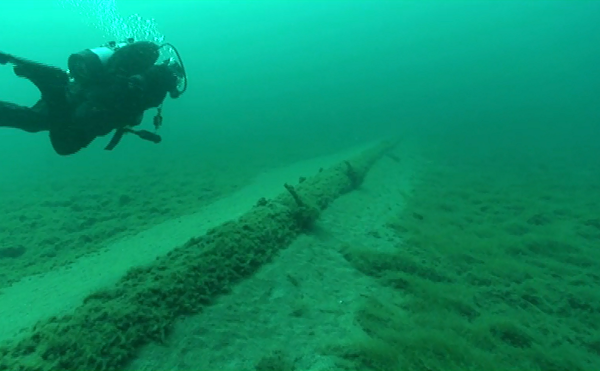"It’s open, so you assume its safe," said Margaret Finch as she helped her daughter dry off from a recent swim in Kensington Metropark’s Kent Lake. "You don’t see any dead fish."
She’s wrong. With no state or federal laws mandating water testing or the closing of contaminated beaches, Michigan swimmers often enter the water at their own risk.
Oakland County, for example, stops testing its beaches approximately one week into August each year, which means that when Finch and her family were swimming, testing was no longer being done. Some counties test their waters through Labor Day; others don’t test at all.
Oakland County health division spokesperson Bob Long says 62 beaches, most of which are public, are tested weekly for about seven weeks each summer; another 224 private beaches are on a five-year rotating schedule.
Yet Michigan Environmental Council Policy Director James Clift says Oakland County appears to have one of the more comprehensive beach testing programs in the state. He points out that Oakland and Macomb are the only Michigan counties with Web sites tracking water quality at their beaches.
Brad Wilson, Clean Water Action’s Michigan program coordinator, thinks Michigan as a whole has a problem
"You don’t see a very high priority placed on beach monitoring in the counties or in Michigan," says Wilson. He contends local governments also lag in notifying swimmers when problems are found.
The U.S. Environmental Protection Agency suggests closing beaches once bacteria counts reach certain levels. According to a July report by the nonprofit Natural Resources Defense Council, Michigan is among the states where beaches aren’t always closed when bacteria counts exceed EPA safety standards.
"A county can decide that they don’t feel like notifying people," says Wilson. "Or if they do, it could be in some newspaper on the back page."
More Oakland closings
So far this year, Oakland County has seen 67 beach closings – more than the total number of closings for any year since 1995, according to the county health division. On June 30 alone, the county closed 27 bathing beaches due to elevated bacteria levels, exceeding the number for all of last year. Long says the county’s health department doesn’t have the resources to make sure all beaches are free of contamination. He admits more beaches would likely have been closed June 30 had his department been able to send employees to test all 286 beaches in the county’s testing program.
"If I put my whole department on sampling, I couldn’t do that," he says.
Long says the bacteria level fluctuation at beaches depends on several factors. The June 30 beach closings were based on water testing following heavy rains, which can cause combined sewers – sanitary sewage and storm water traveling through the same pipe into treatment plants – to overflow. Such overflows can cause partially treated and untreated sewage to enter waters where people swim.
Sewage overflows contribute to the presence of E. coli, a bacteria known to cause gastroenteritis. Swimming with disease-causing organisms is also associated with dysentery, hepatitis, respiratory illness, and ear, nose and throat ailments.
Adding to water pollution is increased urban runoff due to sprawl, says Keith Schneider, executive director of the Michigan Land Use Institute. With more pavement and houses keeping water from soaking into the ground, he says, the rainwater picks up everything from fertilizer to road salts before "rushing like off of a table top into the rivers and the streams and causing a major problem."
No quick fix
Michigan counties could be looking to the Clean Michigan bond money for resources to test their beach waters, but it could take a fight. Of the $675 million in bond money approved by voters last year, $90 million is earmarked to protect and improve water quality; the Engler administration wants half of that to pay for increased monitoring. Environmentalists agree more monitoring is needed, but say that money should come from the state’s general fund. The bond money, they insist, should primarily be used for water pollution cleanup.
However, even if pollution cleanup began tomorrow, environmentalists say, it could be years before swimmers see a substantial reduction in beach closings.
Lana Pollack, head of the Michigan Environmental Council, says construction projects to stop sewage overflows can take years, but lakes contaminated with chemicals such as PCBs could stay poisoned for generations.
Pollack says Michigan’s environment would likely be much dirtier today had the state not followed progressive environmental policies in the 1970s. In the 1990s, she warns, Michigan has yet to feel the full environmental impact of urban sprawl.
"Living off your bank account – we’ve done that," she says. "Now it’s time to put money back in the bank."
Water fight
Where should monitoring money corne from?
If you thought it odd to see environmentalists cooperating with Gov. John Engler and big business to pass the Clean Michigan Initiative last November, the current scenario might seem more familiar.
Some of the same environmentalists are tangling with the administration over how to spend the $90 million in bond money slated for improving water quality.
The Engler administration recommends spending half that $90 million on water monitoring over the next 15 years. His opponents want more of the money for cleaning up water pollution, and for the state to tap the general fund to pay for monitoring, as it has under past administrations.
The Engler administration insists the state’s waters are cleaner than ever. Environmentalists say the gutting of water monitoring programs during this decade makes it impossible to prove that claim, and that, in all likelihood, the problem has grown worse. Continued beach closings, they say, is just one indicator of the need for more emphasis on cleanup.
Strange bedfellows
When Engler first unveiled the bond proposal during his January 1998 State of the State address, environmentalists were skeptical. Some said it was an attempt to greenwash Engler’s poor environmental track record.
Nonetheless, the Michigan Environmental Council and others jumped on the Clean Michigan Initiative bandwagon, spearheading the expansion of the original $500 million proposal to $675 million, with the additional money going to state parks, water pollution cleanup and other projects.
Exactly what was said during that campaign is a point of contention.
Brad Wilson, Michigan program coordinator for Clean Water Action, a bond supporter, says the governor’s advertising push, including TV commercials featuring fellow Republican U.S. Sen. Spencer Abraham, implied the $90 million would be used to clean water bodies such as Lake St. Clair, whose shores are notorious for bacteria-related closings.
Michigan Environmental Council’s James Clift calls the $45 million monitoring proposal a surprise: "There was no general understanding that that was the way that money was to be spent, at least not in our organization."
Not everyone felt blindsided. Keith Schneider, executive director of the Michigan Land Use Institute, says the administration made it clear to his organization before the November vote that between $30 million and $40 million of the clean water money was intended for monitoring over 10 years. Schneider says a refined plan for $45 million over 15 years is no surprise.
Baseless?
During last year’s State of the State address, Engler pronounced: "Michigan’s air, land and water are cleaner today than at any time since record keeping began more than a generation ago."
Critics say at least the water part would be hard, if not impossible to prove.
"If you dismantle your monitoring program, you don’t have any data," Schneider says. "He can’t make that claim."
According to Clean Water Action, Michigan’s funding for water quality monitoring plunged from $480,000 annually between 1985 and 1990 – the year Engler was elected – to $60,000 a year by 1995. In 1995, the state auditor general called the program so inadequate that state officials could not conclude "whether the water quality statewide has improved, remained the same, or degraded."
With monitoring not required at the state or federal level, environmentalists say, Engler’s budget cuts have left most testing – beaches included – to local governments, which test inconsistently within their limited budgets.
Ken Silfven, spokesperson for the Department of Environmental Quality, says the Engler administration chose to dedicate bond money for monitoring because it’s a more stable source than the state’s general fund, since in lean times "water quality monitoring is the first to go."
And he argues the Engler’s administration isn’t the first Michigan administration to have cut water monitoring. "I think it’s disingenuous for them to single out one administration," Silfven says.
Battle to resume
"There is no question that the administration has really dropped the ball on water quality," says State Sen. Gary Peters, D-Bloomfield Township. Peters’ proposal to set aside $10 million of the clean water money for grants to prevent storm water pollution in individual lakes and streams was rejected by Republicans before the Legislature’s summer break.
Peters says he and like-minded legislators intend to keep trying to steer more of the $90 million toward cleanup when the Legislature reconvenes next month.
Schneider agrees it would be better to take money for monitoring from the state’s general fund. However, he says, "We like to deal here with political realities, ...That hasn’t been the reality under this governor and this Legislature in this decade."





